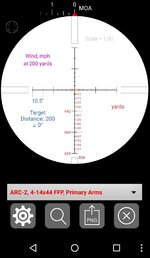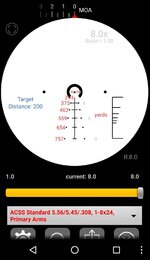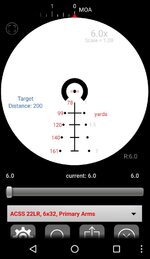- Messages
- 649
- Reactions
- 821
Follow along with the video below to see how to install our site as a web app on your home screen.
Note: This feature may not be available in some browsers.
Yes, BDS. CDC is the center for disease control and a different thing entirely!CDS. Get a dial made specifically for your weapon system (and not a generic 223 or 308).Pick the reticle you like the most, simple of busy, and turn the dial for distance. You are going to be a heck of a lot closer even with the changing temperature/elevations with a custom dial than the BDC.
Plus the Leupold is a better build, both in terms of quality and glass than the Nikon.



Yes, the Spot on app looks amazing. I am wondering if there are users who can tell me how well it works?I agree that a custom dial for your specific bullet weight and velocity is the best option, if you only intend to shoot that specific load. With other loads it will probably be close, but you'd have to verify at range to be certain.
The Nikon BDC is a bit more generic, but it does have one nice feature; the Nikon SpotOn app. This lets you choose the cartridge you are using, and gives the BDC ranges accordingly. For instance, the 300 yard mark might actually be 275 for your cartridge, and 400 might be 350. Not nearly as intuitive as a calibrated dial, but usefull if you use different weights and velocities a lot, or if you intend to share the scope with other calibers. Additionally, it allows you to adjust the zoom level, so you can compare BDC at 3x vs 9x.
One major downside is that too much information can slow you down. Sure, you can have a cheatsheet taped to your stock, but just ranging and dialing in the Leupold is likely faster and more accurate. I'm also not sure of how accurate the program is, so it require a lot of testing at different settings before I could trust it.
For other BDCs besides Nikon, Strelok Pro is an excellent app that allows you to set your specific reticle, load data, and environmental conditions to get your drop.
I've played with Strelok some, but am in no means an expert. I definitely recommend listening to those that regularly shoot long range, and take their opinion over mine.
So, do you use Strelok because you load your own cartridges?I agree that a custom dial for your specific bullet weight and velocity is the best option, if you only intend to shoot that specific load. With other loads it will probably be close, but you'd have to verify at range to be certain.
The Nikon BDC is a bit more generic, but it does have one nice feature; the Nikon SpotOn app. This lets you choose the cartridge you are using, and gives the BDC ranges accordingly. For instance, the 300 yard mark might actually be 275 for your cartridge, and 400 might be 350. Not nearly as intuitive as a calibrated dial, but usefull if you use different weights and velocities a lot, or if you intend to share the scope with other calibers. Additionally, it allows you to adjust the zoom level, so you can compare BDC at 3x vs 9x.
One major downside is that too much information can slow you down. Sure, you can have a cheatsheet taped to your stock, but just ranging and dialing in the Leupold is likely faster and more accurate. I'm also not sure of how accurate the program is, so it require a lot of testing at different settings before I could trust it.
For other BDCs besides Nikon, Strelok Pro is an excellent app that allows you to set your specific reticle, load data, and environmental conditions to get your drop.
I've played with Strelok some, but am in no means an expert. I definitely recommend listening to those that regularly shoot long range, and take their opinion over mine.
Leupold seems to have it's followers as does Nikon, Vortex, etc. Each touts having superior glass.The Leupold custom dial will be more precise, though. 200 yards = 200 yards, 300 = 300, and so on.
If you look at my second example, you can see that the stadia lines often fall on in-between numbers, like the 4 mark equals 375 yards, not what the stadia line is actually designated for. This is because the stadia lines are calibrated for generic 5.56/.308 cartridges, like M193 out of a 16" barrel. I'm using it for 6.5 Grendel, so it doesn't match. I can either memorize these drops or keep a chart with me, but the Leupold would be much more intuitive.
Yes and no. I do reload, but I use Strelok for pretty much everything. It lets me experiment with zeroing at different ranges, zeroing 1" vs 2" high at 100 yards, drop based on velocity, and zero/drop when changing different loads completely, like the 55gr vs 75gr example above. Best of all, it saves me a lot of ammo while doing this!So, do you use Strelok because you load your own cartridges?
They all have different product tiers, too. You have to make sure you are comparing apples to apples.Leupold seems to have it's followers as does Nikon, Vortex, etc. Each touts having superior glass.
Clearly, for me, it's entirely learning to use the scope for range shooting. I figure using the cheaper ammo for target practice, and, later, heavier loads for hunting. During range time, I will also experiment to see which ammo my rifle likes, so I know the most accurate ammo to use for hunting.......
Depends on the purpose.
That makes the CDS system a bit more difficult, as you'll need to use the stock dials until you figure out which load your rifle likes, and then order the custom dials, but that shouldn't be too bad.Clearly, for me, it's entirely learning to use the scope for range shooting. I figure using the cheaper ammo for target practice, and, later, heavier loads for hunting. During range time, I will also experiment to see which ammo my rifle likes, so I know the most accurate ammo to use for hunting.
If I am at range with the yards already measured, it would be point and shoot. Right now, I use outdoor ranges, and I have to walk off the distances. I was planning to use a rangefinder to verify the distances I am shooting to the target. It sounds like the bdc could give me approximate but not exact information?That makes the CDS system a bit more difficult, as you'll need to use the stock dials until you figure out which load your rifle likes, and then order the custom dials, but that shouldn't be too bad.
With either scope your practice ammo will likely have a POI from your hunting ammo, but that's normal.
The big question for me is what you mean by "learning to use the scope for range shooting". Both CDS and BDC are essentially "point and shoot" if you know the distance to your target. You could also go with a mil-dot or an moa scope with hash marks, and learn to use those for estimating ranges too, but that's more advanced than I am. (Personally, I like the ACSS reticles because they incorporate rangefinding into the BDC)
The way I look at it is this: Do anticipate needing to take fast snapshots at different ranges, or do you anticipate having the time to use a laser rangefinder, get comfortable, and dial in your yardage?
BDCs excell at the snapshot scenarios because you just hold over on the appropriate crosshair and shoot. Dials would likely be more precise, but at the expense of having to dial in range before shooting, unless you guess at holdover.
I'm impatient, so I prefer BDCs.
You should see if anyone local has a similar scope you can try, or at least look through. Being able to test drive one would be the best option.
Not all BDCs incorporate rangefinding into the design. I'd stick with the rangefinder plan, as that works with everything.If I am at range with the yards already measured, it would be point and shoot. Right now, I use outdoor ranges, and I have to walk off the distances. I was planning to use a rangefinder to verify the distances I am shooting to the target. It sounds like the bdc could give me approximate but not exact information?